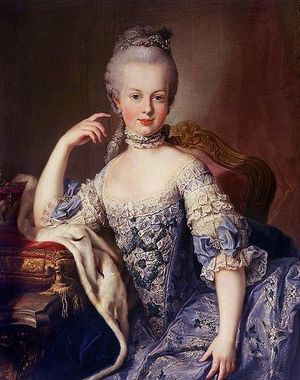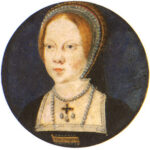Marie Antoinette was born a princess and archduchess on November 2, 1755 in Vienna, Austria. She was the 15th child of Emperor Francis I and Empress Maria Theresa. Francis and Maria were powerful rulers in the Hapsburg monarchy, which ruled Europe for centuries. The Hapsburg family suffered from a genetic deformation of the jaw and lower lip, nicknamed the Hapsburg Jaw and Hapsburg Lip, and Marie Antoinette inherited this condition. Her enlarged lip was usually ignored by artists in the many portraits of the queen.
At the age of 14, Maria Theresa arranged a marriage between Marie Antoinette and the future King Louis XVI of France, who was actually Marie Antoinette’s second cousin once removed. Maria’s Theresa’s reason behind the arrangement was to expand the Hapsburg’s rule to the French court of Versailles. After much negotiations between the two royal families, the decision was settled and Maria Theresa sent the young Marie Antoinette to France. At the Austrian and French border, Marie Antoinette was stripped of her Austrian clothes during a special ceremony and dressed in French clothes before proceeding on to the palace at Versailles.
Marie Antoinette’s marriage was unhappy at first and remained unconsummated for seven years. Marie Antoinette did not find her husband attractive and he was unaffectionate and shy towards his bride. It is believed that the young prince and princess were unaware of how to engage in sex and did not achieve success at the act until Marie Antoinette’s brother had a discussion with the young prince about how to do so.
Seeking escape from her unhappy life at Versailles, Marie Antoinette began to spend lavish amounts of money on clothes, parties, operas and gambling. It was rumored she had an affair with a young soldier named Alex Fersen and had many handsome suitors such as the Duc de Ligne and Count Dillion.
Prince Louis and Marie Antoinette officially became King and Queen of France after King Louis XVI died of smallpox in May of 1774. They were both still teenagers at the time and feared they were too young to rule. Marie Antoinette and her husband were popular at the beginning of their rule but were quickly considered poor leaders only a few years into their reign.
Critics dubbed Marie Antoinette “Madame Deficit” for her lavish spending habits and the royal couple were criticized for not paying close attention to the needs of the country and its people. France struggled with massive debt after many wars during the 1700s. King Louis XVI then pledge major financial support to the American colonies in their war against Britain in 1775. This growing debt and the major crop failures that plagued the country lead to many starving and angry citizens who criticized the King and Queen for not doing enough to help them. This criticism was one of the major causes of the French Revolution.
After many years of marriage, Marie Antoinette and her husband finally conceived a child. Marie-Antoinette gave birth to her first child in 1778 and had four more children over the next 10 years, including two sons. As Marie Antoinette aged, she began spending more time with her family and less time at parties and balls, although it is believed she continued her affair with Alex Fersen.
After a long power struggle and many protests and riots, the French Monarchy lost its control over the country and Marie Antoinette and her family became political prisoners. They were first kept at the Tuileries palace were they made a failed attempt to escape. When the palace was stormed by an angry mob and the Swiss guards were massacred, the family fled and sought refuge with the national assembly, the newly formed government in partial control of the country. After the national assembly voted to end the monarchy, the family were held as prisoners in the Temple tower in Paris. While imprisoned there, her husband was executed and her children were taken from her. Marie Antoinette began to hemorrhage daily due to rapidly developing uterine cancer. A short trial was held and she was convicted of treason. On October 16, 1793, Marie Antoinette was executed by guillotine. Her head was held high for the cheering public to see. Shortly after, her body was thrown into an unmarked grave.
Sources:
Marie Antoinette Biography, Biography.com
Marie Antoinette Biography, Marie Antoinette Online




